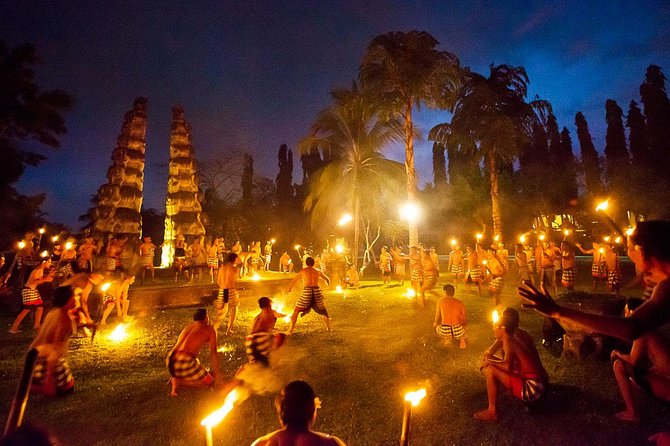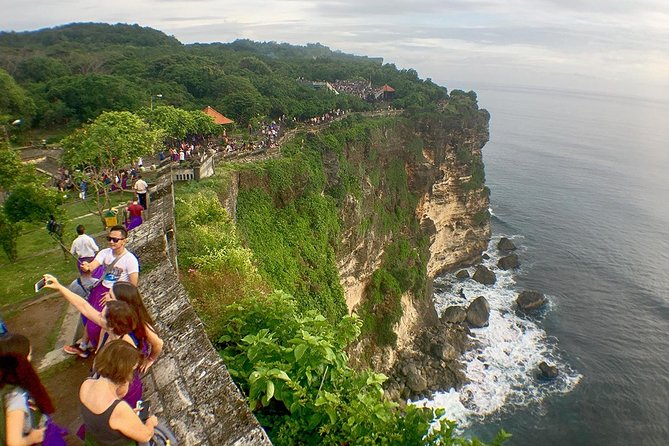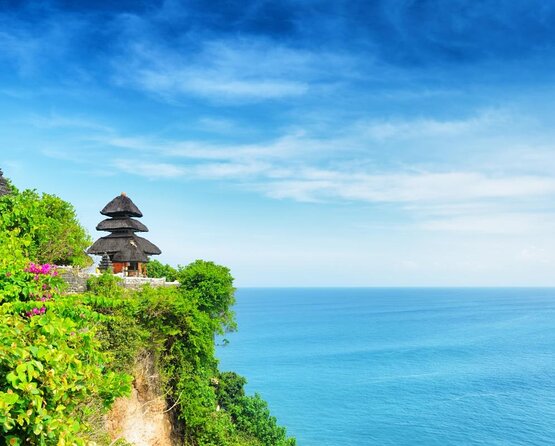Perched on the edge of a rugged cliff, Uluwatu Temple becomes a breathtaking stage for nature’s grand finale as the sun dips below the horizon, painting the sky in a tapestry of colors.
However, the real magic unfolds with the mesmerizing Kecak Fire Dance, a traditional Balinese performance that captivates the senses and transports spectators to a realm of ancient myths and legends.
As dusk settles over the temple, the flickering flames and rhythmic chants create an enchanting atmosphere that beckons visitors to enjoy a cultural experience like no other.
Good To Know

- Experience vibrant sunset colors and cultural rituals at Uluwatu Temple.
- Witness the mesmerizing Kecak Fire Dance based on the Ramayana epic.
- Enjoy the dramatic ocean views and nature’s artistry from the clifftop.
- Immerse in the rich architectural heritage and spiritual significance of the temple at dusk.
Sunset at Uluwatu Temple

Watching the sun set behind the ancient Uluwatu Temple creates a mesmerizing and unforgettable experience for visitors. The vibrant hues of the sky blending with the silhouette of the temple against the horizon make it a perfect setting for sunset photography.
Beyond its visual appeal, the sunset holds deep cultural significance at Uluwatu Temple. As the day transitions into dusk, Balinese Hindu rituals are performed, adding a spiritual aura to the atmosphere. The temple, perched on a cliff overlooking the Indian Ocean, becomes even more enchanting as the sun dips below the horizon.
Visitors can witness the beauty of this moment while appreciating the heritage and traditions that make Uluwatu Temple a revered cultural icon in Bali.
Like evening activities? More Seminyak twilight tours we've written about
Kecak Fire Dance Performance

As the sun sets behind the ancient Uluwatu Temple, visitors are captivated by the captivating Kecak Fire Dance Performance that unfolds against the backdrop of the temple’s silhouette and the evening sky.
This mesmerizing cultural performance combines traditional music with rhythmic chanting and intricate choreography, creating a truly unforgettable experience.
The Kecak Fire Dance, also known as the ‘Monkey Dance,’ tells a story from the Hindu epic, Ramayana, featuring characters like Rama, Sita, and the evil King Ravana.
The dancers, clad in traditional attire, move gracefully around a central flame, their voices harmonizing in a chorus that reverberates through the air.
The flickering flames and enchanting music add an entrancing element to this ancient Balinese art form, leaving spectators in awe of its beauty and cultural significance.
Spectacular Ocean Views
Positioned atop the rugged cliffs of Uluwatu Temple, visitors are treated to breathtaking views of the expansive ocean stretching beyond the horizon.
Ocean Views Highlights:
- Cliffside Beauty: The temple’s vantage point offers a dramatic view of the ocean meeting the sky, surrounded by the natural beauty of the cliffs.
- Nature’s Wonders: Witness the interplay of the sun’s golden hues with the deep blue waters, creating a mesmerizing sight that showcases nature’s artistry.
- Panoramic Serenity: Gaze out at the vastness of the sea, feeling a sense of peace and tranquility as the waves crash against the cliffs below.
Visitors can enjoy these awe-inspiring vistas, connecting with the raw beauty of the natural world at this enchanting location.
Temple Architecture and History
Perched on the cliffs of Uluwatu, the temple stands as a testament to both the rich architectural heritage and storied history of this sacred site. The architecture analysis reveals intricate stone carvings, traditional Balinese pagodas, and majestic sea views that blend harmoniously with the natural landscape.
The temple’s historical significance dates back to the 10th century when it was built to protect the island from evil spirits. Over the centuries, it has become a symbol of spiritual devotion and cultural preservation for the Balinese people.
Visitors can witness the centuries-old architecture and feel a sense of reverence as they explore the temple grounds, gaining a deeper understanding of Bali’s rich cultural tapestry.
- Tanah Lot Sunset Private Tour
- VIP Private Boat to Nusa Penida: Snorkeling With Mantas Land Tour Adventure
- Wonderful Bali In 3 Days Private Tour
- Ubud Waterfalls Private Tour With Driver/Guide/Photographer – Seminyak
- Uluwatu Half-Day Private Tour With Temple Entrance – Seminyak
- Ubud Small Group Tour: Monkey Forest, Tegalalang Rice Terraces and More
Best Time to Visit Uluwatu
Nestled atop the cliffs of Uluwatu, visitors can experience the breathtaking beauty of this sacred temple at various times of the day.
To make the most of a visit to Uluwatu, consider the following:
Sunset Photography: The golden hour before sunset casts a magical glow over the temple, providing the perfect backdrop for stunning photographs.
Cliffside Dining: Enjoy a romantic dinner at one of the cliffside restaurants nearby. The combination of delicious food and a panoramic view of the ocean creates a memorable dining experience.
Early Morning Exploration: Beat the crowds by visiting Uluwatu early in the morning. The tranquil atmosphere and gentle morning light offer a serene and peaceful way to appreciate the temple’s beauty.
Tips for Enjoying the Experience
To fully take in the Uluwatu Temple experience, visitors can enhance their visit by following these insightful tips. For capturing stunning sunset photography, it’s recommended to arrive early to secure a good spot and witness the changing hues of the sky. The temple’s cliff-top location provides a perfect vantage point for this.
Plus, indulge in the local cuisine available at the nearby stalls. Try traditional Balinese dishes like Nasi Goreng or Satay to savor authentic flavors. Remember to respect the temple’s sacred atmosphere by dressing modestly and be prepared for the mischievous monkeys that inhabit the area.
Local Culture and Traditions
Local Balinese culture and traditions are richly woven into the fabric of daily life, offering visitors a vibrant tapestry of customs and rituals to explore and appreciate.
Traditional Performances: Balinese culture is renowned for its traditional dance and music performances, showcasing the island’s artistic heritage through vibrant costumes, intricate movements, and rhythmic melodies.
Cultural Heritage: The island’s cultural heritage is evident in the intricate temple architecture, religious ceremonies, and daily offerings that reflect the deep spiritual beliefs and traditions of the Balinese people.
Community Involvement: Many cultural events and rituals involve community participation, highlighting the strong bonds and collective spirit that are integral to Balinese traditions and way of life.
How to Get to Uluwatu Temple
Visitors can easily access Uluwatu Temple by following the well-marked road signs directing towards the temple entrance. For those seeking transportation options, renting a scooter or hiring a local driver are popular choices. The temple is around a 45-minute drive from Kuta, making it convenient for travelers staying in the popular tourist areas of Bali.
Sunset photography opportunities at Uluwatu Temple are unparalleled, with the stunning ocean backdrop and the temple perched on a cliff. Arriving a bit before sunset allows visitors to explore the temple grounds, find the best vantage points, and capture the magical moment when the sun dips below the horizon. Remember to secure your belongings and be cautious of the mischievous monkeys that inhabit the temple grounds.
Common Questions
What Is the Significance of the Kecak Fire Dance Performance at Uluwatu Temple?
The kecak fire dance is a mesmerizing performance art with deep cultural significance in Balinese culture. This traditional dance ritual, featuring rhythmic chanting and intricate movements, embodies the spiritual essence and storytelling traditions of the region.
Are There Any Restrictions or Guidelines for Photography During the Sunset at Uluwatu Temple?
Photography restrictions and sunset guidelines are important considerations at Uluwatu Temple. Visitors should respect cultural norms and refrain from disruptive behavior. Capturing the beauty of the sunset is encouraged, but be mindful of the surroundings and other visitors.
Is There a Dress Code or Attire Recommendation for Visitors Attending the Kecak Fire Dance Performance?
Visitors attending the Kecak Fire Dance should adhere to local dress code norms. It is recommended to wear modest attire out of respect for the cultural significance of the performance. Compliance enhances the overall experience.
Are There Any Local Vendors or Shops Selling Souvenirs Near Uluwatu Temple?
Local vendors near Uluwatu Temple offer traditional crafts and souvenirs. Visitors can explore unique items like handmade textiles, wood carvings, and local artwork. Bargaining is common, making it a lively shopping experience for travelers.
Are There Any Specific Rituals or Ceremonies That Take Place at Uluwatu Temple During Special Occasions or Festivals?
Traditional ceremonies and cultural practices at Uluwatu Temple include vibrant celebrations during special occasions. Festive events draw locals and travelers to witness unique rituals. The temple’s rich history intertwines with these colorful ceremonies, offering a captivating experience.
The Sum Up
As the sun dips below the horizon, casting a golden glow over Uluwatu Temple, the Kecak Fire Dance begins its mesmerizing performance.
The rhythmic chants and flickering flames create a mystical ambiance that transports visitors to a realm of ancient tales and folklore.
With its stunning ocean views and rich cultural heritage, a visit to Uluwatu Temple during sunset is an unforgettable experience that immerses you in the magic of Bali.
More Evening Tours in Seminyak
- Half-Day Bali Car Charter for Private Evening Tour in Ubud
- Famous Temples Tour With Tanah Lot Sunset
- Bali Cycling Adventure and Tanah Lot Sunset Tour
- Private Half-Day Tour: Tanah Lot Sunset Tour With Dinner Packages
- Bali Water Sports and Spa Packages With Sunset Dinner at Jimbaran
- Bali Swing Activities and Tanah Lot Sunset Tour
More Tour Reviews in Seminyak
Looking for something different? Other Seminyak activities we've written about
- Sunrise Jeep Bali
- 25 Best Guided Tours In Seminyak
- 25 Best Tours In Seminyak
- 25 Best Workshops And Classes In Seminyak
- 10 Best Shopping Tours In Seminyak
- 20 Best Spa And Hot Springs Experiences In Seminyak
- 20 Best Massage And Relaxation Services In Seminyak
- 10 Best Historical Tours In Seminyak
- 10 Best Dolphin Watching Tours In Seminyak
- 20 Best 3 Day Tours In Seminyak
- 25 Best Snorkeling Experiences In Seminyak
- 20 Best Full-Day Tours In Seminyak
